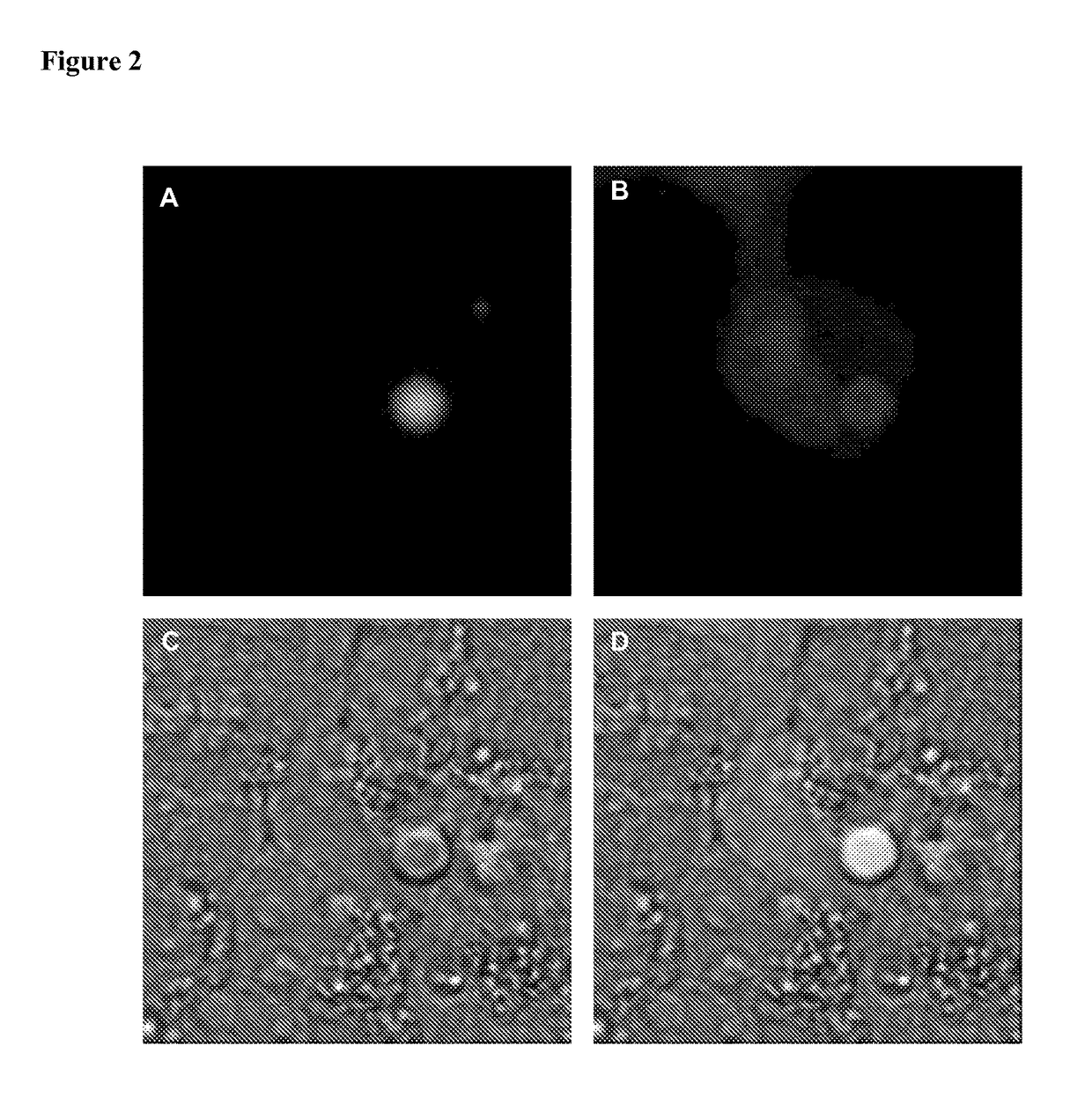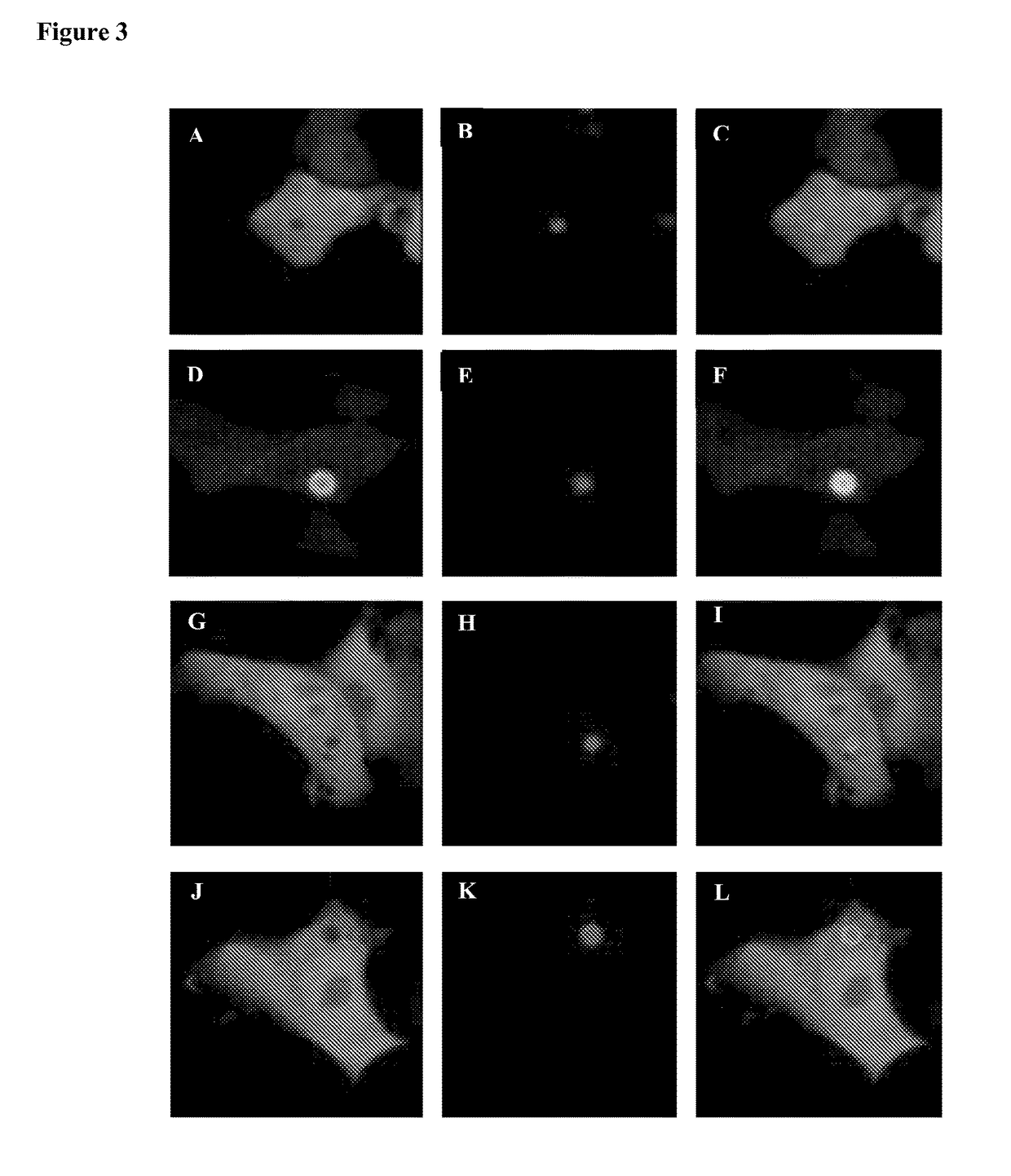Method for antigen delivery
a bioactive molecule and antigen technology, applied in the field of new antigen and/or bioactive molecule delivery methods, can solve the problems of short shelf life of both liposomes and hydrogels, inability to fusion hapten and klh coding sequences by molecular cloning methods, and inability to express klh protein in bacteria or hapten and klh coding sequences, etc., to prolong the time period of antigens
- Summary
- Abstract
- Description
- Claims
- Application Information
AI Technical Summary
Benefits of technology
Problems solved by technology
Method used
Image
Examples
specific embodiments
Example 1
[0071]Synthesis of the composition containing the ASC speck carrier and mCherry proteins fused to ASC proteins forming the ASC speck carrier in HEK 293 FT cells and its purification from HEK 293 FT cell culture.
[0072]The DNA sequence encoding an antigen or a bioactive molecule in peptide or protein nature, is cloned into a plasmid containing ASC protein (SEQ ID NO: 1) coding sequence in a way that they will form a fusion protein. The plasmid should preferably contain an SV40 origin of replication (e.g. pcDNA3 or pEGFP-C3 vector backbone). The plasmid created accordingly is transfected into a selected cell line in order to overexpress the ASC-antigen (or bioactive molecule) fusion protein. HEK 293 FT cell line was used in this invention because it multiplies SV40 origin of replication containing plasmids in high copy numbers inside the cells.
[0073]pmCherry-C3.1-ASC plasmid encoding mCherry-ASC fusion protein was transfected into HEK 293 FT cells by calcium-phosphate method. ...
example 2
[0079]Synthesis of a fused DNA sequence encoding the mCherry-ASC fusion protein.
[0080]In order to clone pmCherry-C3.1-ASC plasmid that encodes for mCherry-ASC fusion protein, the DNA sequence encoding the human ASC protein was obtained from pcDNA3-ASC plasmid by digesting with HindIII-EcoRI enzymes and ligated to the multiple cloning site of pmCherry-C3.1 vector digested with same enzymes to create an mCherry-ASC fusion protein coding sequence. The pcDNA3-ASC plasmid was a gift from Gabriel Nunez (University of Michigan, Ann Arbor, USA).
[0081]In order to clone pmCherry-C3.1 plasmid, the mCherry protein coding sequence was PCR amplified from pcDNA3 IFP 1.4 plasmid using primers NheI_mCherry_F (gctagcaccatggtgtctaagggcgaaga) and XhoI_mCherry_R (ctcgagtttcttgtacagctcgtccat). The EGFP protein coding sequence was digested and removed from the pEGFP-C3 plasmid by NheI-XhoI enzymes and PCR product digested with same enzymes was ligated to its place. pcDNA3 IFP 1.4 was a gift from Tsien Lab...
example 3
[0083]Alternative methods of loading antigens and / or bioactive molecules to the ASC speck carrier.
[0084]FGF2 (fibroblast growth factor 2, SEQ ID NO: 10) loaded to the ASC speck carrier was given as an example of bioactive molecules which can be loaded to the ASC speck carrier. The FGF2 protein is a growth factor known to have role in angiogenesis, embryonic development and wound healing.
[0085]When it is desirable to load an antigen or a bioactive molecule to ASC specks without creating a fusion protein with the ASC protein (SEQ ID NO: 1), the plasmid containing the DNA sequence encoding the antigen and / or the bioactive molecule and the plasmid containing the DNA sequence encoding the ASC protein are co-transfected into the preferred cell line.
[0086]As an example, the plasmid encoding mCherry-FGF2 fusion protein was co-transfected with the plasmid encoding EGFP-ASC fusion protein. A mixture of mCherry-FGF2 and EGFP-ASC encoding plasmids, 1 μg each, were mixed in a total 219 μl volume...
PUM
| Property | Measurement | Unit |
|---|---|---|
| molecular weight | aaaaa | aaaaa |
| temperature | aaaaa | aaaaa |
| volume | aaaaa | aaaaa |
Abstract
Description
Claims
Application Information
 Login to View More
Login to View More - R&D
- Intellectual Property
- Life Sciences
- Materials
- Tech Scout
- Unparalleled Data Quality
- Higher Quality Content
- 60% Fewer Hallucinations
Browse by: Latest US Patents, China's latest patents, Technical Efficacy Thesaurus, Application Domain, Technology Topic, Popular Technical Reports.
© 2025 PatSnap. All rights reserved.Legal|Privacy policy|Modern Slavery Act Transparency Statement|Sitemap|About US| Contact US: help@patsnap.com



